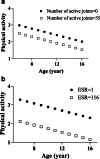Clinical and psychosocial stress factors are associated with decline in physical activity over time in children with juvenile idiopathic arthritis
- PMID: 34187498
- PMCID: PMC8243495
- DOI: 10.1186/s12969-021-00584-4
Clinical and psychosocial stress factors are associated with decline in physical activity over time in children with juvenile idiopathic arthritis
Abstract
Background: Physical activity (PA) patterns in children with juvenile idiopathic arthritis (JIA) over time are not well described. The aim of this study was to describe associations of physical activity (PA) with disease activity, function, pain, and psychosocial stress in the 2 years following diagnosis in an inception cohort of children with juvenile idiopathic arthritis (JIA).
Methods: In 82 children with newly diagnosed JIA, PA levels, prospectively determined at enrollment, 12 and 24 months using the Physical Activity Questionnaire for Children (PAQ-C) and Adolescents (PAQ-A) raw scores, were evaluated in relation to disease activity as reflected by arthritis activity (Juvenile Arthritis Disease Activity Score (JADAS-71)), function, pain, and psychosocial stresses using a linear mixed model approach. Results in the JIA cohort were compared to normative Pediatric Bone Mineral Accrual Study data derived from healthy children using z-scores.
Results: At enrollment, PA z-score levels of study participants were lower than those in the normative population (median z-score - 0.356; p = 0.005). At enrollment, PA raw scores were negatively associated with the psychosocial domain of the Juvenile Arthritis Quality of Life Questionnaire (r = - 0.251; p = 0.023). There was a significant decline in PAQ-C/A raw scores from baseline (median and IQR: 2.6, 1.4-3.1) to 24 months (median and IQR: 2.1, 1.4-2.7; p = 0.003). The linear mixed-effect model showed that PAQ-C/A raw scores in children with JIA decreased as age, disease duration, and ESR increased. The PAQ-C/A raw scores of the participants was also negatively influenced by an increase in disease activity as measured by the JADAS-71 (p < 0.001).
Conclusion: Canadian children with newly diagnosed JIA have lower PA levels than healthy children. The decline in PA levels over time was associated with disease activity and higher disease-specific psychosocial stress.
Keywords: Juvenile arthritis; Physical activity; Psychosocial stress.
Conflict of interest statement
None identified. The authors declare that they have no competing interests.
Figures



References
-
- Sherman G, Nemet D, Moshe V, et al. Disease activity, overweight, physical activity and screen time in a cohort of patients with juvenile idiopathic arthritis. Clin Exp Rheumatol. 2018;36(6):1110–1116. - PubMed
Publication types
MeSH terms
LinkOut - more resources
Full Text Sources
Medical
Miscellaneous

